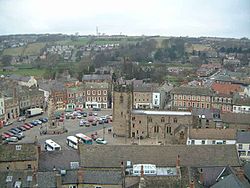Richmond, Yorkshire
| Richmond | |
| Yorkshire North Riding | |
|---|---|
 Richmond, seen from the castle | |
| Location | |
| Grid reference: | NZ170009 |
| Location: | 54°24’13"N, 1°44’14"W |
| Data | |
| Population: | 8,970 |
| Post town: | Richmond |
| Postcode: | DL10 |
| Dialling code: | 01748 |
| Local Government | |
| Council: | Richmondshire |
| Parliamentary constituency: |
Richmond (Yorks) |
Richmond is a pretty market town on the River Swale in the North Riding of Yorkshire. The town stands on the edge of the Yorkshire Dales National Park.
Richmond's picturesque appearance and historic buildings have made it a popular film and television location. Productions using the town have included Century Falls, A Woman of Substance, All Creatures Great and Small and Earthfasts (a story inspired by the legend of the drummer-boy).
Richmond appears in the Domesday Book of 1086 as Hindrelag suggesting an earlier Old English form, but now takes its name from town of Richemont in Normandy. The town and its lands belonged to Earl Edwin of Mercia at the time of the Norman Conquest but when Edwin rose up against the Normans in 1071, William the Conqueror confiscated the town and its lands from him and granted them to Alan of Brittany, who named his new capital from the Norman town. The lands of the "Honour of Richmond" in the North Riding became known as "Richmondshire", replacing an earlier name, "Gillingshire".
It is now reckoned that of all British place-names, "Richmond" is the most duplicated, with 55 occurrences worldwide.
Around and about the town

Richmond Castle, in the town centre overlooking the River Swale, is a major tourist attraction. The castle was begun in 1071, and altered over the years until it fell out of use in the 14th century.
Scolland's Hall is the castle gatehouse and was staffed by the Lords of Bedale, including such names as Bryan FitzAlan, Lord FitzAlan, and Miles Stapleton.
To Richmond belonged also a series of nearby castles in Wensleydale initially consisting of Middleham Castle, Ravensworth and Snape.
The Green Howards Regimental Museum is based in the old Trinity Church in the centre of the town's market place; the town is also home to the Richmondshire Museum.
The Georgian Theatre, founded in 1788 by the actor, Samuel Butler, is just off the market place. A decline in the fortunes of theatre led to its closure in 1848 and it was used as a warehouse for many years. In 1963 the theatre was restored and reopened, with a theatre museum added in 1979. More recently, the theatre has become the "Georgian Theatre Royal" and was extended in 2003 with the addition of a new block providing services and access next to the original auditorium.
History
Richmond was refounded in 1071 by the Breton Alan Rufus on lands granted to him by William the Conqueror. Richmond Castle, completed in 1086, consisted of a keep with walls encompassing the area now known as the Market Place.
After Alan's death, the Honour of Richmond was inherited by his kinsman the Duke of Brittany. The honour was normally held by the Duke of Brittany from 1136 to 1399, and thus the Dukes of Brittany were vassals of both Valois France, in right of Brittany, and Plantagenet England, in right of Richmond. The need thus to maintain territory between two warring kingdoms caused tension in Breton history, particularly during the great Breton War of Succession and the Wars of the Roses.
In 1322 at the Battle of Old Byland, Walter Stewart, 6th High Steward of Scotland led an assault on Richmond and in battle John of Brittany, Earl of Richmond was captured.
In the Middle Ages Richmond prospered as a market town and centre of the Swaledale wool industry.
The estates of Richmond and the title "Earl of Richmond" were eventually lost to the Breton Dukes in the Breton Wars of Succession. Henry Tudor inherited the title, under which name he defeated and slew Richard III at the Battle of Bosworth. As King Henry VII he founded Richmond Palace at Sheen in Surrey and thus gave the Yorkshire town's name to a southern estate which became Richmond, Surrey.
During the English Civil War, the Covenanter Army led by Lord Newark marched south and took Richmond Castle, the occasion of trouble between the Roman Catholic recusants in the town's population and the Presbyterian Covenanters.
The town's wealth greatly increased in the late 17th and 18th centuries with the burgeoning lead mining industry in nearby Arkengarthdale. It is from this period that the town's attractive Georgian architecture originates, the most notable examples of which are to be found on Newbiggin and in Frenchgate.
The Legend of the Drummer-boy
Legend tells that nearly 200 years ago some soldiers found an entrance to a tunnel near the castle keep. They could not fit into the tunnel so they elected to send a regimental drummer boy. The boy was asked to walk along the tunnel and beat his drum so that above ground the soldiers could follow the noise. They did this for 3 miles before the sound stopped unexpectedly. This was never explained and today a stone marks the spot the noise stopped. More confusingly the entrance can also not be found.
Today schools celebrate this local legend with children marching through town annually. Legend claims that on some cold nights you can hear the faint sound of the drummer boy still.
References
Outside links
- A History of Richmond : edited from Langdale's Yorkshire Dictionary (1822) and Baine's Directory of the County of York (1823).
- Robinson's Guide to Richmond :(1833).
- A Brief History of Richmond
- Richmondshire Museum
- Official Guide to Richmond